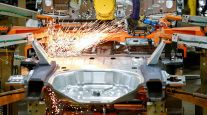ATA Economic Summit Will Assess Health of Key Industries Using Trucking Services
This story appears in the June 19 print edition of Transport Topics.
Fleet executives will get a chance to check out the health of their customers’ industries at an economic summit, where chief economists from nine trade associations provide briefings on the current state of those business groups and what is expected in coming months.
 Bob Costello
Bob CostelloSponsored by American Trucking Associations, the summit will convene in Arlington, Va., on July 19-20. Industries represented will include manufacturing, construction and retail.
ATA Chief Economist Bob Costello will serve as moderator for the participants, which will be capped at 100.
Costello said he staffed three panels with speakers who could provide insight on the nation’s “three big buckets of freight”: consumer spending, nearly 70% of the U.S. economy; housing and construction; and the industrial economy, including manufacturing, chemicals and metal production.
Costello will lead a fourth panel on trucking to close the event with Kenny Vieth, president of ACT Research Co.
“I’m excited to hear what they’ll have to say,” Costello said.
U.S. manufacturing is worth about 12% of the nation’s gross domestic product, said Chad Moutray, chief economist of the National Association of Manufacturers and a panelist.
“Beyond that, we have large tentacles throughout the economy,” with each company having numerous suppliers. Moutray said manufacturers have been hurt by the strong U.S. dollar, “but the situation has stabilized since the fall.”
He forecasts general strengthening for manufacturing, but “some pockets are still struggling.”
Homebuilders contribute 3.5% to 4% of GDP, said Michael Neal of the National Association of Home Builders, another panelist.
New homes, multifamily structures and renovations — known as residential fixed investment — were pulverized during the recession.
“The good news is, we’re off the bottom from that,” Neal said, but the current issue is, “How long to get back to normal?” Residential fixed investment equivalent to about 6% of GDP would be considered typical, Neal said.
A broader measure of housing services, including rents, mortgage payments, existing home sales and real estate fees, is about 12% of GDP, he said.
Neal said the industry needs to attract young people, especially carpenters and bricklayers.
Representing the consumer sector, Steven Szakaly of the National Automobile Dealers Association said automakers and dealers enjoyed boom times in 2015 and 2016, setting back-to-back sales records — about 17.4 million cars and light trucks last year. For this year, he forecasts sales of 17.1 million vehicles and 16.7 million in 2018, are “very good years but not records.”
Szakaly emphasized the mutually beneficial relationship between the automotive industry and for- hire trucking.
“Everything our industry sells, whether parts or new cars, spends some time in or on a truck, at least once,” he said. Trains play a role in longer shipping, he said, but ultimately, every new car gets to a dealership on an auto hauler.
“If any industry has an outsize impact on trucking logistics, this is it,” Szakaly said.
Costello, who leads the Eyes on the Economy panels during the federation’s annual Management Conference & Exhibitions, said the summit is designed to be a large-scale version of those panels.
“This will be not just the tip of the iceberg, but the whole iceberg,” he said.




